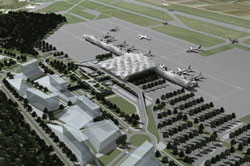
Zagreb Airport
With Croatia set to become a full member of the European Union in the near future – possibly as early as this year – Zagreb Airport has made a firm commitment to constantly improve both facilities and service quality in order to prepare for the extended service of the wider European community.
“The expansion of the airport’s capacities for aircraft, passenger and cargo handling, and the development of a new passenger terminal in the future, will further strengthen Zagreb Airport’s position as one of the regional leaders,” said Tonci Peovic, General Manager.
While passenger numbers dropped by 4% last year, the airport still handled in excess of two million passengers and, due to this positive figure, initial plans have recently been agreed for the construction of a new terminal to cater for additional demand.
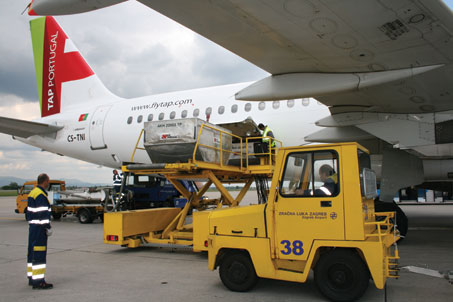
Peovic: “The expansion of the airport’s capacities for aircraft, passenger and cargo handling, and the development of a new passenger terminal in the future, will further strengthen Zagreb Airport’s position as one of the regional leaders.”
Peovic said: “Generally speaking, the airport acts as the gateway to south-east Europe. When compared to other airports in the region, Zagreb Airport appears to be one of the most robust markets so we feel that the airport is well placed to perform strongly in the near future.”
With the refurbishment of passenger facilities and an increase in capacity vital to the continued growth of the airport, improvements to its cargo operations are also a vital factor with regard to the long-term plan. In 2009, the airport handled more than 11 tonnes of freight and mail and currently has warehouse space to handle up to 15-20 tonnes of cargo annually.
“One of our projects, which aims to bring a new quality level of service is the implementation of a new CIS-Cargo Information System,” Peovic explained. “We expect to start work on this on 1 May and the plans for the new Zagreb Airport cargo infrastructure facilities envisage advanced cargo and warehouse facilities, compliant to Cargo 2000 standards, that will have easy access to intermodal operations.
“It will also ultimately take greater advantage of the airport’s existing location on major highway axes connecting Austria, Germany, Italy, Slovenia, Hungary, Serbia and Bosnia and Herzegovina to Zagreb and the Adriatic Sea ports.”
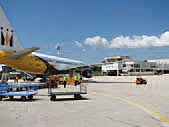
Having experienced a steady increase in passenger numbers in recent years, Pula Airport’s annual passenger figures peaked at more than 397,000 in 2008.
Pula Airport
Pula Airport, located on the north-west coast of Croatia, has a long tradition as one of the former Yugoslavia’s main civilian and military airports. After the unrest of the war brought it to a virtual standstill, the past four years have seen a steady increase in passenger numbers, attracted by the quiet and unspoiled part of the Adriatic. In 2008, passenger numbers peaked at more than 397,000.
Pula Airport aims to be a modern airport designed to deliver first-class operational facilities both to airlines and passengers. Its staff ensures efficient ground services, providing short turnaround times and simple passenger processing. With an established and flourishing tourist industry and increasing business activity, Pula Airport is perfectly placed to enjoy sustained growth over the next decade and to establish itself as a primary gateway to the northern Adriatic.
The airport provides landing and handling services for a variety of aircraft, from small jets to Boeing 747s, and it can deal with the arrival and departure of up to ten aircraft and 5,000 passengers at a time, rising to 10,000 on peak days. Low-cost carriers using the airport have made a great impact and the market shows good growth potential with budget airlines continually showing an interest in the region.
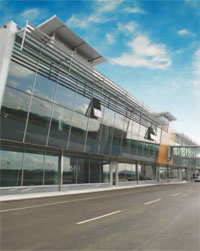
Ljubljana Airport will close for 15 days in April as the final stage of the runway renovation takes place.
Ljubljana Airport
Since Slovenia’s entry into the European Union in 2004, Ljubljana Airport has undergone major renovation and in April, the airport will close for 15 days as the next stage of its redevelopment is completed.
Following the extension of the main terminal in 2007 and, among other works, an extension to the taxiway and the construction of a new general aviation centre, the third and final stage of the runway renovation will take place between 7 and 21 April.
The first and second stages of the project, which focused on the east and west sides of the runway, were completed last summer when the airport stayed open for business and operated with a shortened 2,100m-long section. However, due largely to safety issues, the final stage will require the complete closure of Slovenia’s busiest airport and traffic will instead be diverted to Maribor and Portorož airports.
“The renovation will, above all, increase the safety of the runway,” explained Zmago Skobir, President of the Management Board. “The construction work involved in the renovation of the runway includes the renovation of asphalt surfaces across the entire breadth of the runway over a length of approximately 3,000m, renovation of asphalt surfaces on part of the taxiways, replacement of the lighting system with cable connections and installation of additional cable trenches.”
In addition to the €9 million contractual value of the runway project, the loss of income during the closure of the airport is estimated to be €1.2 million but Skobir insists that a full closure is absolutely necessary.
“Based on economic estimates and the assessed level of risk for traffic activity, and after harmonisation with airport users and the ministry of transport, it was decided that Ljubljana Jože Pucnik Airport Airport be closed to all traffic,” he said.
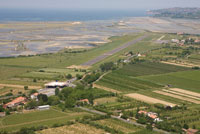
During the final stage of the runway improvement project at Ljubljana Airport, Jat Airways will divert its operations to Portorož airport.
Portorož Airport
During the final stage of the runway renovation project at Ljubljana Airport, Jat Airways will divert its operations 145km south-west to Portorož Airport.
Located just 6km away from the cosmopolitan area of Portorož, it is the third busiest international airport in Slovenia.
With runway dimensions of 1,200m x 30m, and with night-flight lighting equipment, the airport is well equipped to receive the additional traffic.
In 2009, Portorož Airport, along with the Slovenian Ministry for Transport, developed an analysis of the area around the airport and earlier this year, it was given permission to produce and submit a national spatial plan; a positive decision with regard to the airport’s development plans.
These plans include the proposed extension of the runway by 200m, an extension to the apron area and the construction of new hangars.







